by Patricia Herbig
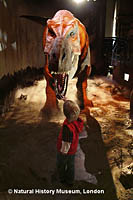 A couple of years ago, the Government decided that everyone should be able to take advantage of the wonderful museums that London has to offer; it made them all free. As a result, they are now more crowded, but as tourists, you won’t have the added expense of entry fees. My family particularly enjoys the Natural History Museum. As with all large museums, it’s best to pick a couple exhibits to see, other wise everyone is overwhelmed and the kids especially have a bad time.
A couple of years ago, the Government decided that everyone should be able to take advantage of the wonderful museums that London has to offer; it made them all free. As a result, they are now more crowded, but as tourists, you won’t have the added expense of entry fees. My family particularly enjoys the Natural History Museum. As with all large museums, it’s best to pick a couple exhibits to see, other wise everyone is overwhelmed and the kids especially have a bad time.
There’s something for everyone in the NHM. It is divided into two main sections: Earth Sciences and Life Sciences.
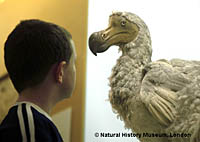 The Life Sciences section has huge fossils and dinosaur skeletons and a special exhibit in which they have a life-sized T-Rex which moves and roars. It’s a bit scary for very little children, so be warned. Other treats are rare stuffed birds, including a dodo. There are wonderful small and large fossils found along the southwest coast (named the Jurassic Coast) of England. The exhibit on Creepy Crawlies attracts kids of all ages back again and again.
The Life Sciences section has huge fossils and dinosaur skeletons and a special exhibit in which they have a life-sized T-Rex which moves and roars. It’s a bit scary for very little children, so be warned. Other treats are rare stuffed birds, including a dodo. There are wonderful small and large fossils found along the southwest coast (named the Jurassic Coast) of England. The exhibit on Creepy Crawlies attracts kids of all ages back again and again.
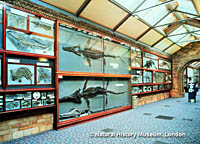 Our favorites are probably the fossils and dinosaurs and the area with the dioramas of prehistoric and modern animals. The huge fossils of prehistoric sea animals displayed on the walls are truly impressive. The smaller ones in the cases inspired us to go to Dorset and the Jurassic coast to look for more -which we indeed found!
Our favorites are probably the fossils and dinosaurs and the area with the dioramas of prehistoric and modern animals. The huge fossils of prehistoric sea animals displayed on the walls are truly impressive. The smaller ones in the cases inspired us to go to Dorset and the Jurassic coast to look for more -which we indeed found!
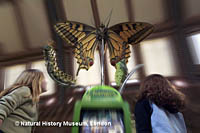 The Earth Sciences exhibits are reached up a long escalator in the main entry hall. You enter through a gallery of rare crystals in cases which are lit with black light to enhance the color
The Earth Sciences exhibits are reached up a long escalator in the main entry hall. You enter through a gallery of rare crystals in cases which are lit with black light to enhance the color
[one_third_last]. While there are many interesting exhibits in this side of the museum, our favorite
[three_fourth_last] is the section which explains earthquakes and volcanoes. The volcano of Mount Pinatubo in The Philippines and the Kobe ( Japan) earthquake are featured in a series of photographs and simply written explanations.
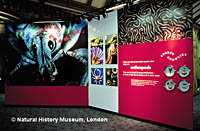 There is also a room fitted out as a small grocery shop in Kobe. Every couple of minutes, there is a recreation of what it would have been like to have been in the shop at the moment of the earthquake – initial tremours, then stronger and stronger shaking.
There is also a room fitted out as a small grocery shop in Kobe. Every couple of minutes, there is a recreation of what it would have been like to have been in the shop at the moment of the earthquake – initial tremours, then stronger and stronger shaking.
The Natural History Museum is open M-Sa, 10.00 – 17.30, Su 11.00 – 17.30. Admission is free. Additional information:www.nhm.ac.uk Address: Cromwell Road, London SW7 TEL: 020-7942-5000 Public transport: South Kensington Tube
